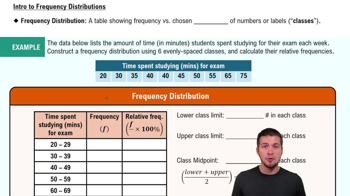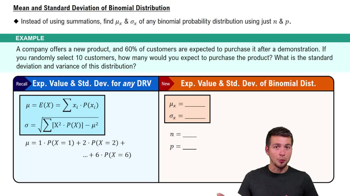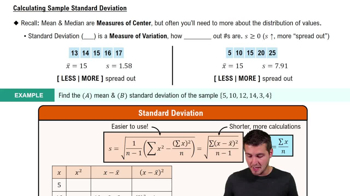Standard Normal Distribution. In Exercises 13–16, find the indicated z score. The graph depicts the standard normal distribution of bone density scores with mean 0 and standard deviation 1.
Table of contents
- 1. Intro to Stats and Collecting Data1h 14m
- 2. Describing Data with Tables and Graphs1h 55m
- 3. Describing Data Numerically2h 5m
- 4. Probability2h 16m
- 5. Binomial Distribution & Discrete Random Variables3h 6m
- 6. Normal Distribution and Continuous Random Variables2h 11m
- 7. Sampling Distributions & Confidence Intervals: Mean3h 23m
- Sampling Distribution of the Sample Mean and Central Limit Theorem19m
- Distribution of Sample Mean - Excel23m
- Introduction to Confidence Intervals15m
- Confidence Intervals for Population Mean1h 18m
- Determining the Minimum Sample Size Required12m
- Finding Probabilities and T Critical Values - Excel28m
- Confidence Intervals for Population Means - Excel25m
- 8. Sampling Distributions & Confidence Intervals: Proportion1h 12m
- 9. Hypothesis Testing for One Sample3h 29m
- 10. Hypothesis Testing for Two Samples4h 50m
- Two Proportions1h 13m
- Two Proportions Hypothesis Test - Excel28m
- Two Means - Unknown, Unequal Variance1h 3m
- Two Means - Unknown Variances Hypothesis Test - Excel12m
- Two Means - Unknown, Equal Variance15m
- Two Means - Unknown, Equal Variances Hypothesis Test - Excel9m
- Two Means - Known Variance12m
- Two Means - Sigma Known Hypothesis Test - Excel21m
- Two Means - Matched Pairs (Dependent Samples)42m
- Matched Pairs Hypothesis Test - Excel12m
- 11. Correlation1h 6m
- 12. Regression1h 50m
- 13. Chi-Square Tests & Goodness of Fit1h 57m
- 14. ANOVA1h 57m
6. Normal Distribution and Continuous Random Variables
Probabilities & Z-Scores w/ Graphing Calculator
Problem 6.1.50
Textbook Question
Distributions In a continuous uniform distribution,

a. Find the mean and standard deviation for the distribution of the waiting times represented in Figure 6-2, which accompanies Exercises 5–8.
 Verified step by step guidance
Verified step by step guidance1
Identify the minimum and maximum values of the waiting times from the given distribution or figure. These values are necessary to calculate both the mean (μ) and the standard deviation (σ).
Use the formula for the mean of a continuous uniform distribution: μ = (minimum + maximum) / 2. Substitute the identified minimum and maximum values into this formula.
Calculate the range of the distribution, which is the difference between the maximum and minimum values: range = maximum - minimum.
Use the formula for the standard deviation of a continuous uniform distribution: σ = range / √12. Substitute the calculated range into this formula.
Simplify the expressions for both the mean and standard deviation to obtain the final results. Ensure all calculations are consistent with the provided formulas.
 Verified video answer for a similar problem:
Verified video answer for a similar problem:This video solution was recommended by our tutors as helpful for the problem above
Video duration:
1mPlay a video:
Was this helpful?
Key Concepts
Here are the essential concepts you must grasp in order to answer the question correctly.
Continuous Uniform Distribution
A continuous uniform distribution is a probability distribution where all outcomes are equally likely within a specified range. This means that any value between the minimum and maximum is equally probable, leading to a flat probability density function. The distribution is defined by its two parameters: the minimum and maximum values, which determine the range of possible outcomes.
Recommended video:
Guided course

Intro to Frequency Distributions
Mean of a Uniform Distribution
The mean (μ) of a continuous uniform distribution is calculated as the average of the minimum and maximum values. It represents the central point of the distribution and is given by the formula μ = (minimum + maximum) / 2. This value indicates where the center of the distribution lies, providing insight into the expected value of a random variable drawn from this distribution.
Recommended video:
Guided course

Mean & Standard Deviation of Binomial Distribution
Standard Deviation of a Uniform Distribution
The standard deviation (σ) of a continuous uniform distribution measures the spread of the distribution around the mean. It is calculated using the formula σ = range / √12, where the range is the difference between the maximum and minimum values. A larger standard deviation indicates a wider spread of values, while a smaller standard deviation suggests that the values are closer to the mean.
Recommended video:
Guided course

Calculating Standard Deviation

 7:09m
7:09mWatch next
Master Probability From Given Z-Scores - TI-84 (CE) Calculator with a bite sized video explanation from Patrick
Start learningRelated Videos
Related Practice
Textbook Question
